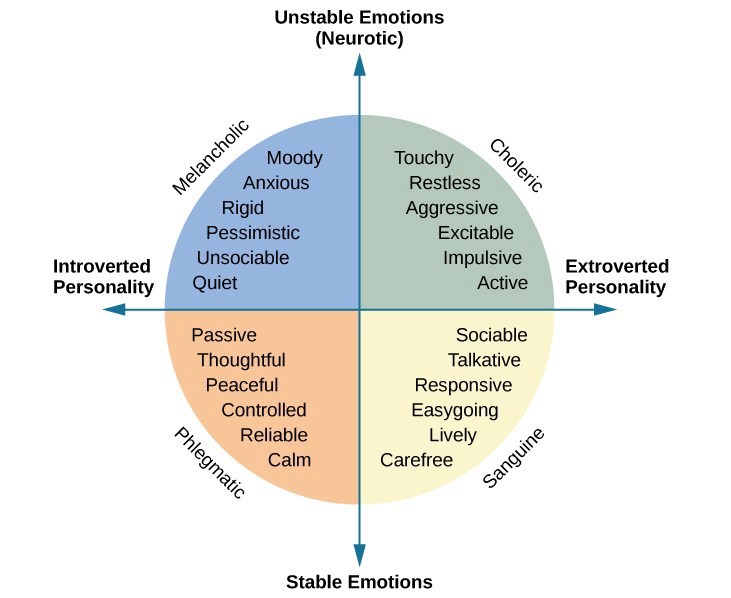<< Hide Menu
Dalia Savy
John Mohl
Haseung Jun
Mary Valdez
Dalia Savy
John Mohl
Haseung Jun
Mary Valdez
Trait Theorists
Trait theorists believe that we can describe people's personalities by specifying their main characteristics 😎 These characteristics are thought to be stable and to motivate behavior with the specific trait. Trait theorists are most likely to claim that personality is genetic 🧬
Gordon Allport
Allport was the one that first described personality through traits, which are patterns of behavior.
- cardinal traits - defining characteristic
- central traits - general characteristics that form behavior

Image Courtesy of mollychandlerxx.
Factor analysis, from the intelligence unit, comes back here. It is a procedure used to find clusters of traits that are similar and make up your personality.
Every personality test that you take online is a trait personality test, and there are so many different types.
Hans Eysenck
Hans Eysenck is one who believes in the nomothetic approach: the belief that the same basic set of traits can be used to describe all people’s personalities 🌎He believed that by classifying all people along an introversion-extraversion scale and a stable-unstable scale, we could easily describe their personalities. Three dimensions played a key role: extroversion, neuroticism, and psychoticism. Extroversion means sociability and ability to pay attention to outside world and environment. Neuroticism measures our level of instability and psychoticism measures our level of tough-mindedness.

Image Courtesy of Medium.
If you are passive, you are also thoughtful, peaceful, controlled, reliable, and calm.
Isabel Myers and Katharine Briggs
You could probably identify the type of personality test they created by their last names: the Myers-Brigg Type Indicator (MBTI). They mostly studied surface traits and source traits, which are visible areas of personality and underlying personality characteristics, respectively. It is used all around the world and there are four main sections of the test:
- Favorite world
- 😊Extroverted—outgoing, energetic, sociable. Do you find yourself more attached to communicating with others?
- 🎨Introverted—gentle, quiet, caring, logical. Do you find yourself focused on yourself and being alone?
- Information
- 🔰Sensing—organized, observant. Do you focus more on what is given to you?
- 🤔Intuition (N)—logical, conceptual, insightful. Do you interpret and add meaning to the information that is given to you?
- Decisions
- ❤️Feeling type—sensitive, appreciative, tactful. Do you put more weight on personal concerns?
- ⚖️Thinking type—are good at analyzing pros and cons and are logical. Do you put more weight on facts and objective?
- Structure
- 💭Judging—determined, concrete. Do you stay to what you know?
- 🔎Perceiving—independent, questioning, adaptable. Do you stay open to new things? You don't really have to know the specifics, but it's really interesting to fit yourself into each category. Here's the link if you want to take the test and see if you guessed correctly. Have some fun with what you learn!
This information was adapted from the Myers-Brigg Website.
Here is a diagram of the different personality types that come from these four traits:

Image Courtesy of Mouth Foods.
Raymond Cattell
Cattell created the 16 PF (personality factor) which measures what he believed were the 16 basic traits present in all people, but to different degrees. It is unlikely that you have to know the 16 factors.
Paul Costa and Robert McCrea
Paul Costa & Robert McCrea proposed that personality can be described using the big five personality traits:
- 📆Openness—Do you like change? Can you adapt to it? - Low score: practical, prefers routine, comforting- High score: imaginative, prefers variety, independent
- 🧮Consciousness—Are you organized and careful? - Low score: disorganized, careless, impulsive- High score: organized, careful, disciplined
- 😊Agreeableness—How well do you get along with others? - Low score: ruthless, suspicious, uncooperative- High score: soft-hearted, trusting, helpful
- 🗣️Extroversion—Are you shy or outgoing? - Low score: retiring, sober, reserved- High score: sociable, affectionate, fun-loving
- 😬Neuroticism—Are you anxious often? - Low score: calm, secure, self-satisfied- High score: anxious, insecure, self-pitying

Image Courtesy of Wikipedia.
These five traits, unlike the past few types of personality tests, should be memorized. Use the mnemonic device "OCEAN" to help.
Comparing Personality Theories
To compare the personality theories you learned in the past few key topics, here is a nice table:
| Personality Theory | Key Proponents | Assumptions | View of Personality |
| Psychoanalytic | Freud | Emotional disorders spring from unconscious dynamics, such as unresolved sexual and other childhood conflicts, and fixation at various developmental stages. Defense mechanisms fend off anxiety. | Personality consists of pleasure-seeking impulses (the id), a reality-oriented executive (the ego), and an internalized set of ideals (the superego) |
| Psychodynamic | Adler, Horney, Jung | The unconscious and conscious minds interact. Childhood experiences and defense mechanisms are important. | The dynamic interplay of conscious and unconscious motives and conflicts shape our personality. |
| Humanistic | Rogers, Maslow | Rather than examining the struggles of sick people, it's better to focus on the ways healthy people strive for self-realization. | If our basic human needs are met, people will strive toward self-actualization. In a climate of unconditional positive regard, we can develop self-awareness and a more realistic and positive self-concept. |
| Trait | Allport, Eysenck, McCrae, Costa | We have certain stable and enduring characteristics, influenced by genetic predispositions. | Scientific study of traits has isolated important dimensions of personality, such as the Big Five traits. |
| Social-Cognitive | Bandura | Our traits and the social context interact to produce our behaviors. | Conditioning and observational learning interact with cognition to create behavior patterns. |
Table Courtesy of Propertarianism. All credit to David G. Myers and Nathan DeWall
🎥 Watch: AP Psychology—Personality Theories
🏆 Trivia—Personality, Motivation, and Emotion

© 2024 Fiveable Inc. All rights reserved.